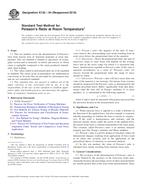We need your consent to use the individual data so that you can see information about your interests, among other things. Click "OK" to give your consent.
ASTM E132-04(2010)
Standard Test Method for Poisson´s Ratio at Room Temperature
STANDARD published on 1.9.2010
The information about the standard:
Designation standards: ASTM E132-04(2010)
Note: WITHDRAWN
Publication date standards: 1.9.2010
SKU: NS-41283
The number of pages: 3
Approximate weight : 9 g (0.02 lbs)
Country: American technical standard
Category: Technical standards ASTM
The category - similar standards:
Annotation of standard text ASTM E132-04(2010) :
Keywords:
axial strain, longitudinal strain, Poisson´s ratio, stress-strain diagram, transverse strain, Room temperature, Poisson&apos,s ratio, ICS Number Code 19.060 (Mechanical testing)
Additional information
| Significance and Use | ||||||||||||
|
When uniaxial force is applied to a solid, it deforms in the direction of the applied force, but also expands or contracts laterally depending on whether the force is tensile or compressive. If the solid is homogeneous and isotropic, and the material remains elastic under the action of the applied force, the lateral strain bears a constant relationship to the axial strain. This constant, called Poisson's ratio, is an intrinsic material property just like Young's modulus and Shear modulus. Poisson's ratio is used for design of structures where all dimensional changes resulting from application of force need to be taken into account, and in the application of the generalized theory of elasticity to structural analysis. In this test method, the value of Poisson's ratio is obtained from strains resulting from uniaxial stress only. |
||||||||||||
| 1. Scope | ||||||||||||
|
1.1 This test method covers the determination of Poisson's ratio from tension tests of structural materials at room temperature. This test method is limited to specimens of rectangular section and to materials in which and stresses at which creep is negligible compared to the strain produced immediately upon loading. 1.2 The values stated in inch-pound units are to be regarded as standard. The values given in parentheses are mathematical conversions to SI units that are provided for information only and are not considered standard. 1.3 This standard does not purport to address all of the safety concerns, if any, associated with its use. It is the responsibility of the user of this standard to establish appropriate safety and health practices and determine the applicability of regulatory limitations prior to use. |
||||||||||||
| 2. Referenced Documents | ||||||||||||
|
Similar standards:
Historical
1.7.2014
Historical
15.7.2010
Historical
1.1.2010
Historical
1.8.2013
Historical
1.8.2008
Historical
1.12.2010
We recommend:
Technical standards updating
Do you want to make sure you use only the valid technical standards?
We can offer you a solution which will provide you a monthly overview concerning the updating of standards which you use.
Would you like to know more? Look at this page.



 ASTM C1314-14
ASTM C1314-14 ASTM C1322-05b(2010)..
ASTM C1322-05b(2010).. ASTM C1323-10
ASTM C1323-10 ASTM C1326-13
ASTM C1326-13 ASTM C1327-08
ASTM C1327-08 ASTM C1337-10
ASTM C1337-10
 Cookies
Cookies
